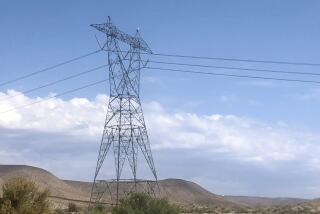Racers Fade in the Shade : Solar power: A Cal State Northridge team was unprepared for thundershowers obscuring the sun during parts of an 11-day Florida-to-Michigan rally.
- Share via
After placing 19th out of 32 cars in the Florida-to-Michigan solar race with a car they had feverishly worked to build, Cal State Northridge engineering students this week attributed their disappointing showing to a combination of bad luck and lean finances.
In particular, they were unprepared for the drought-busting thundershowers that obscured the sun during parts of the first six of 11 race days, leaving them trailing the front-runners by nearly 40 hours at the finish line on July 19.
“We were anticipating to run in the sun,” said student and project leader Manny Sanchez.
“We could have run in drizzles but . . . this was a wall of water. The clouds were moving faster than we were at some points.”
Thirty-six CSUN students also raised only about $40,000 in cash and material to build their car, the Blazer, while the University of Michigan’s Sunrunner, which won the competition, cost 20 times that much--about $800,000.
Even before the race began, CSUN students complained about the size of Michigan’s reported expenditures and its use of professional consultants to help design and build the vehicle.
“Not to put Michigan down--they did have a nice car,” Sanchez said. “But a lot of the people there were upset about who built that nice car and the fact that money won the race.”
Clearly, though, money was not the only factor that separated the winning cars, which cruised at 45 m.p.h., from the pack of CSUN competitors, who traveled at top speeds of about 25 m.p.h.
The Massachusetts Institute of Technology, which placed sixth in the race even after a crash, spent only $30,000 on its squat, buglike Galaxy.
Each daily stage of the race was about 200 miles.
The cars were given credit for the portion they completed and were trucked the rest of the way.
Other problems dogged CSUN’s entry.
A miniature computer inside the CSUN car, intended to send information back to a larger computer in the chase car, was not working in time to qualify for the race.
A shipment of new batteries also arrived too late to start the race and the car had to be pulled off the road for five hours a few days later for the battery exchange.
And one of the engineering instructors, who had crewed a car in the international solar race in Australia, was injured in a fall the day the Blazer left for the Midwest and could help out only intermittently.
Barely completing the Blazer in time for the race also placed CSUN at a disadvantage, Sanchez said.
Other colleges and universities had time for trial runs.
Some even had driven the actual course ahead of time, he said, and knew precisely when to slow down to save energy for upcoming hills.
“We were right up to the wire. The first day of the race trials was our first time running with a complete system,” he said. “Actually, we didn’t do that bad if you look at it from that point of view.”
The high points of the race were when the team maneuvered through small towns on secondary roads, Sanchez said.
Even though they were traveling at low speeds, he said, people waved and cheered them as if they were in the Indy 500.
Low points came at the end of long, wet days, when the team sometimes ran the car until twilight--amid much arguing among team members--to try to get a head start on the next day, he said.
They even arrived too late for the lobster dinner served the evening before the final race day.
When asked whether the race was worth the effort of building the car--which kept a core group of senior engineering students busy many long nights this year--Sanchez paused.
“A year’s worth of time?” he asked. “Well, yes, it was definitely worth it. If I ever need to build another solar car, I would know how to do it.”
More to Read
Go beyond the scoreboard
Get the latest on L.A.'s teams in the daily Sports Report newsletter.
You may occasionally receive promotional content from the Los Angeles Times.








